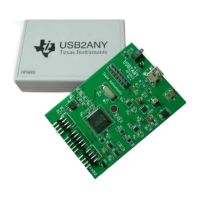Overview of Hardware Design
www.ti.com
4
SNAU228–January 2018
Submit Documentation Feedback
Copyright © 2018, Texas Instruments Incorporated
USB2ANY Interface Adapter
2 Overview of Hardware Design
The USB2ANY is based on TI’s MSP430F5529 microcontroller, which has the following features making it
ideal for a multi-interface controller:
• 16-bit RISC CPU
• Operates at 3.3 V
• 128KB flash memory
• 10KB SRAM
• 63 I/O pins
• Fast execution (25-MHz clock)
• Four 16-bit counters and timers
• Two universal serial communication interfaces (supports SPI, I
2
C, UART)
• Full-speed universal serial bus (USB) with internal PHY supporting USB 2.0
• 12-bit ADC
• Hardware multiplier supporting 32-bit operations
• Three-channel internal DMA
See Appendix A: USB2ANY Schematic for schematic drawings.
The block diagram in Figure 2 shows the fundamental parts of the USB2ANY:
1. USB connector – The USB connector connects to the host computer. The USB2ANY is a
USB 2.0 full-speed device using a HID-class driver. The board has a Mini-USB connector installed.
2. Power Management – The power management circuitry allows the application program to turn the
+3.3-V or the +5.0-V external power outputs on or off. It also detects power faults (for example,
overload or short circuit) and notifies the application program.
3. MSP430F5529 – This MSP430 microcontroller communicates with the application program and
executes the received API function commands. It is programmed with the USB2ANY firmware, which
controls all of the interface peripherals and other necessary functions (for example, timing, scheduling,
encoding and decoding data).
4. DAC1, DAC2 – These are the DAC outputs. Under program control, these outputs can source a
voltage from 0 V to 3.3 V, in 256 steps.
5. GPIO – These GPIO signals are used to read/write single-bit digital signals. When used as inputs, they
can optionally be programmed to be pulled up, pulled down, or floating (MOS input with no resistor).
6. I
2
C – The inter-integrated circuit interface is an industry-standard serial interface often used to
communicate between devices in a closed system. I
2
C requires two signal wires plus a ground
connection. The I
2
C interface of the USB2ANY uses a 7-bit address, which allows the bus to support
up to 127 devices.
7. SPI – The industry-standard serial peripheral interface is generally faster than I
2
C, but more difficult to
implement. It is often used to communicate between devices in a closed system. SPI usually requires
four signal wires plus a ground connection, but can use as few as three wires or as many as needed to
select among the number of devices connected to the bus. While there is no real limit as to the
maximum number of devices on a SPI bus, the number is usually limited by practical issues like fan-
out, cable length, signaling speed, and capacitive loading.
8. PWM – The pulse-width modulated outputs allow the USB2ANY to produced pulse trains with variable
frequency and duty cycle. This can be used for clocks, integrators (such as those used in PWM servo
motors), tone generation, and so forth.
9. Analog Inputs – The USB2ANY has four analog inputs. Two of the inputs (ADC0, ADC1) have no
external amplifiers (effectively unity gain) and the other two inputs (ADC2, ADC3) have a gain of two.
The gain allows smaller signals to be amplified slightly, giving them a larger scale at the ADC inputs.
The MSP430F5529 utilizes 12-bit ADCs, giving a full-scale digital value of 4095.
10. Ext. V
REF
– The external voltage reference allows selection of the voltage used as the reference by the
ADCs. By default, V
REF
is set to use AV
CC
, which is physically connected to V
CC
(3.3-V nominal).

